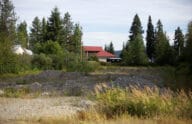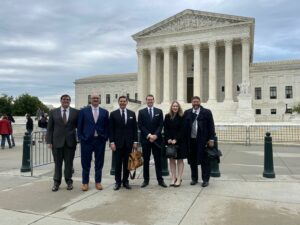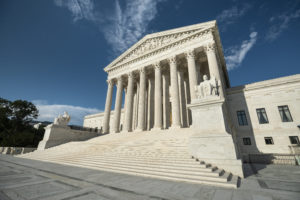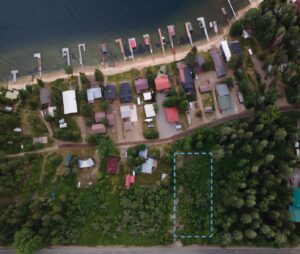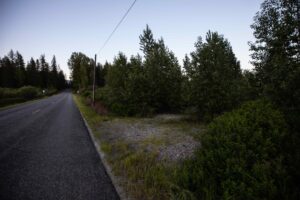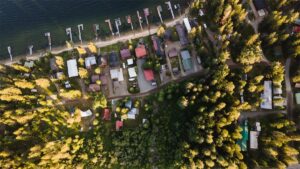Sackett v. EPA: A timeline
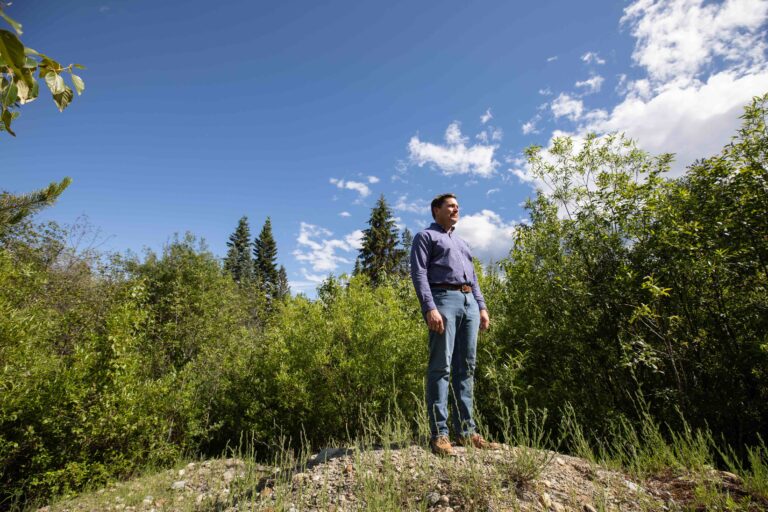
Mike and Chantell Sackett have been fighting the EPA in court for 15 years. Here’s a timeline of their case:
2004:
Mike and Chantell Sackett purchase a vacant lot in a residential subdivision near Priest Lake, Idaho. At its north end, the lot is bounded by paved Kalispell Bay Road, on the other side of which runs a manmade ditch. To the south of the lot, across graveled Old Schneider Road, is a row of houses that fronts Priest Lake. No surface water connection exists between the Sacketts’ lot and the roadside ditch, or between their lot and Priest Lake.
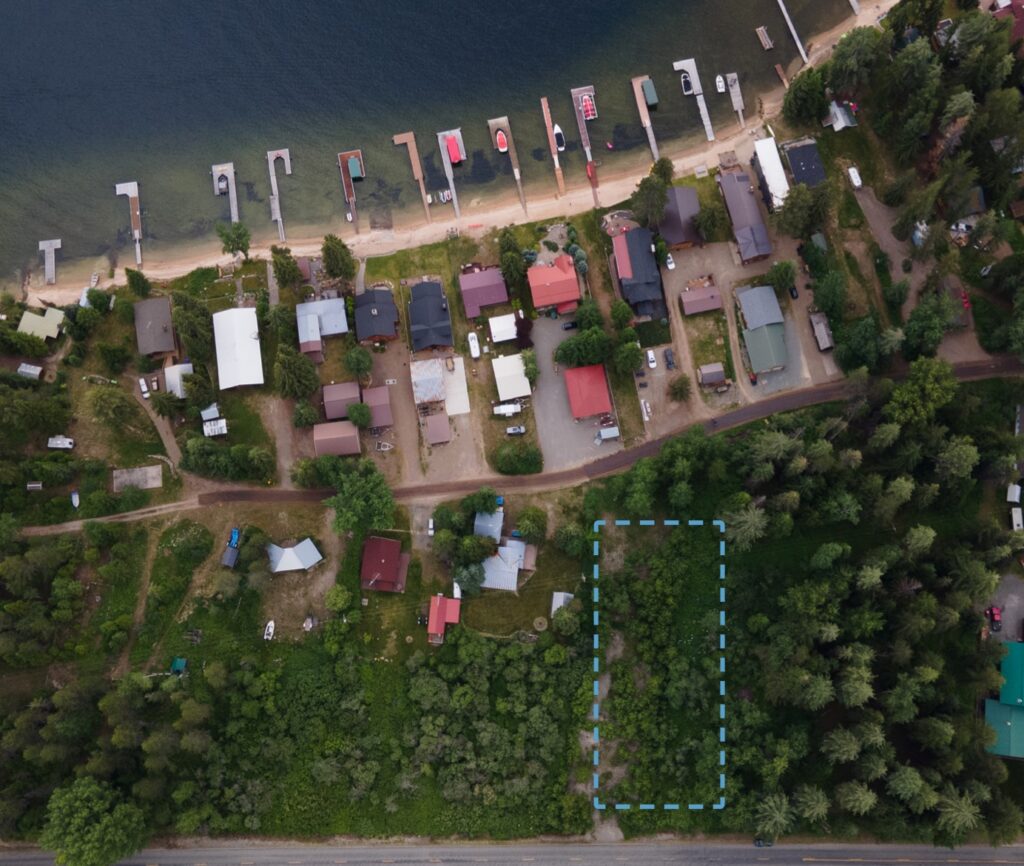
The Sacketts’ lot is marked with a blue dashed line.
2007:
April—The Sacketts begin construction on their family home.
May—After the Sacketts break ground, officials from the EPA and the United States Army Corps of Engineers inform the Sacketts’ construction crew that the lot likely contains wetlands subject to regulation under the Clean Water Act (CWA). The officials recommend that all construction cease until the Sacketts’ compliance with the Act can be established.
June—The EPA sends the Sacketts a “Request for Information” concerning their homebuilding project. The request asks the Sacketts to detail all construction activities undertaken on their lot. The EPA gives the Sacketts fifteen days to respond.
July—The Sacketts respond to the EPA’s request explaining that they have all local building permits in hand, that their site is bordered by developed properties and roads, and that nothing in their deed of title or other paperwork suggested that their lot contains wetlands.
August—The EPA informs the Sacketts that the agency needs to do “additional research” and inquires whether the Sacketts intend to comply with its “request” that they remove the fill from their property.
The Sacketts request a “response from the EPA in writing as to a rational reason why the property . . . needs to be reclaimed.” They note that the agency has still not provided “any official notification in writing of any violation.”
November—The The EPA finds that the Sacketts violated the Act by trying to build their home without first obtaining a Clean Water Act permit, and orders them to refrain from further construction and to immediately restore their property. The Sacketts are threatened with tens of thousands of dollars per day in administrative and civil penalties if they fail to comply.
2008:
April—The Sacketts request an administrative hearing and an opportunity to contest the EPA’s determinations that their property contains wetlands subject to the EPA’s authority under the CWA. The EPA denies that request, and the Sacketts, represented by PLF, file an action against the EPA in the United States District Court for the District of Idaho under the Administrative Procedure Act (APA). The Sacketts argue that the EPA’s compliance order is arbitrary and capricious because the Clean Water Act does not grant the EPA the authority to regulate their property.
May—The EPA moves to dismiss the Sacketts’ suit, arguing that the compliance order is not judicially reviewable under the APA because it is not “final agency action” and that the Sacketts are therefore precluded from challenging the administrative compliance order.
August—The District Court rules in the EPA’s favor, holding that the compliance order is not judicially reviewable.
October—The Sacketts appeal the District Court’s ruling to the Ninth Circuit Court of Appeals, arguing that the compliance order is judicially reviewable because it is “final agency action” under the APA and that the EPA lacks the authority to regulate their property.
2009:
December—The Ninth Circuit hears oral argument in the Sacketts’ case.
2010:
September—The Ninth Circuit affirms the District Court and holds that the compliance order is not judicially reviewable, effectively denying the Sacketts any recourse to challenge the EPA’s assertion of authority over their lot.
2011:
February—The Sacketts file a petition for a writ of certiorari, asking the Supreme Court to hear their case.
June—The Supreme Court grants certiorari and agrees to hear the Sacketts’ case limited to the following questions: “May the petitioners [Sacketts] seek pre-enforcement judicial review of the administrative compliance order pursuant to the Administrative Procedure Act? If not, does petitioners’ [the Sacketts’] inability to seek pre-enforcement judicial review of the administrative compliance order violate their rights under the Due Process Clause?”
2012:
January—The Supreme Court hears oral argument in Sackett v. EPA.
March—In a unanimous opinion authored by Justice Scalia, the Supreme Court holds that the Sacketts can challenge the EPA’s compliance order in court because it is “final agency action” under the APA and thus subject to judicial review. The Court reverses the Ninth Circuit and remands the case to the lower courts for further proceedings consistent with its opinion.
Fall 2012–Early 2015:
Numerous procedural delays follow remand from the Supreme Court.
The Sacketts and the EPA litigate various procedural issues at the District Court, including litigation over the case’s record.
Fall 2015–Winter 2017:
The Sacketts and the EPA litigate the merits in the United States District Court for the District of Idaho to determine whether the Sacketts’ property contains wetlands that qualify as “navigable waters” subject to the EPA’s authority under the Clean Water Act.
The Sacketts originally argue that the EPA lacks jurisdiction over their homebuilding project under Justice Kennedy’s significant nexus test from Rapanos v. United States. But after the Ninth Circuit decides United States v. Davis, which analyzed how to apply fractured decisions like Rapanos, the Sacketts argue that Justice Scalia’s plurality opinion is the controlling rule of law. Under this test, wetlands are regulable only if they have a continuous surface water connection to other regulated waters. The Sacketts argue that because their lot lacks this connection, EPA lacks authority over their site.
Winter 2017–Winter 2019:
Briefing is concluded, and the District Court considers the Sacketts’ case.
March 2019—The District Court rules that the EPA has authority to regulate the wetlands alleged to exist on the Sacketts’ lot pursuant to Justice Kennedy’s “significant nexus” test from Rapanos, under which wetlands are regulable if they, either alone or in combination with other “similarly situated” wetlands in the “region,” significantly affect the physical, chemical, or biological integrity of a traditional navigable water.
May 2019—The Sacketts appeal the District Court’s ruling that their property is regulable under the CWA to the Ninth Circuit.
December 2019—The Sacketts file their opening brief at the Ninth Circuit arguing that the EPA lacks jurisdiction under the CWA over their homebuilding project. The Sacketts principally argue that the Rapanos plurality and that the District Court erred by applying Justice Kennedy’s “significant nexus” test to determine the scope of the EPA’s regulatory authority over their lot.
2020:
March—After the Sacketts file their opening brief in the Ninth Circuit, the EPA withdraws the administrative compliance order and makes a non-binding commitment to refrain from issuing another order. But the EPA still asserts that it has the authority to regulate the Sacketts’ property under the CWA.
April—The EPA moves to dismiss the Sacketts’ appeal at the Ninth Circuit, arguing that the case is moot because the EPA rescinded its administrative compliance order.
May—A motions panel denies the EPA’s motion to dismiss the case as moot without prejudice.
August—A merits panel definitively rejects the EPA’s claim that its voluntary withdrawal of the administrative compliance order moots the case, holding that the Sacketts’ appeal remains live despite the EPA’s voluntary, non-binding commitment because the Sacketts’ “central legal challenge” to the EPA’s jurisdiction remains “unresolved.”
November—The Sacketts’ case is argued at the Ninth Circuit.
2021
August—The Ninth Circuit affirms the ruling of the District Court and holds that Justice Kennedy’s significant nexus test controls questions of wetlands jurisdiction. The court also affirms the EPA’s jurisdiction over the Sacketts’ lot because (i) the property contains, within the meaning of EPA’s regulations, “wetlands” that are “adjacent” to a “tributary” of Priest Lake (namely, the roadside ditch), and (ii) the lot’s purported wetland, in combination with wetlands on the other side of a road, bear a significant nexus to Priest Lake.
September—The Sacketts file a petition for a writ of certiorari, asking the Supreme Court to decide, once and for all, the proper test for wetlands jurisdiction under the CWA and whether the Sacketts’ lot is regulable under the CWA.
2022
January—The Supreme Court grants certiorari and agrees to hear the Sacketts’ case limited to the following question: “Whether the Ninth Circuit set forth the proper test for determining whether wetlands are “waters of the United States” under the Clean Water Act, 33 U.S.C. § 1362(7).”
March—The Sacketts submit their opening brief on the merits at the Supreme Court, offering a framework for determining when a wetland is among “the waters of the United States” and thus subject to the CWA’s regulation of “navigable waters”:
Step One: Is the wetland inseparably bound up with a “water”—i.e., a stream, ocean, river, lake, or similar hydrogeographic feature that in ordinary parlance would be called a “water”—by means of a continuous surface-water connection, such that it is difficult to tell where the wetland ends and the “water” begins?
Step Two: Is the “water” among “the waters of the United States,” i.e., those waterbodies subject to Congress’s authority over the channels of interstate commerce?
The Sacketts argue that this framework, unlike the significant nexus test applied below, is constitutionally sound, faithful to the statutory text of the CWA, and easily applied. Under this framework, the Sacketts’ property is not regulable under the CWA because (i) the lot does not contain hydrogeographic features ordinarily referred to as “waters” and there is no continuous surface-water connection to any other “water,” and (ii) even if there are wetlands on the lot, they are not inseparably bound up with a “waters of the United States” because the roadside ditch that the EPA based its jurisdiction on is not a traditional navigable water subject to Congress’s authority over the channels of interstate commerce.


